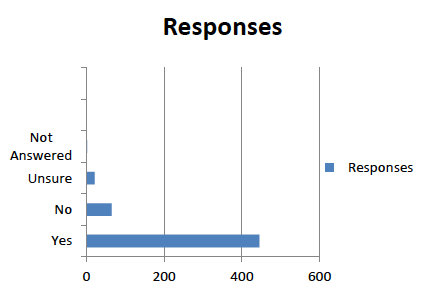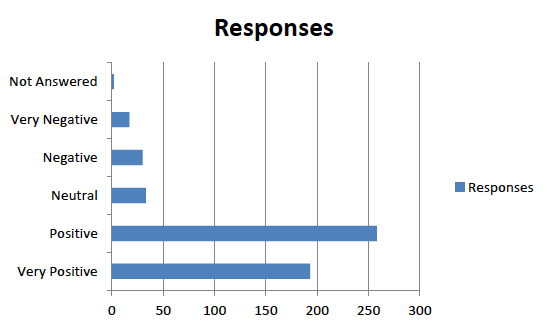Beavers in Scotland: consultation analysis
The purpose of this consultation was to give stakeholders an opportunity to provide feedback on the policy decision to reintroduce beavers to Scotland.
Chapter 2. Analysis of Responses
Number of Responses
The Scottish Government received 533 responses to this consultation, both from organisations (39) and individuals (494). The organisations included a range of stakeholders including 20 countryside management and representative bodies, 19 charities/campaign groups and a large number of individuals from across Scotland.
Copies of the responses can be found here https://consult.gov.scot/forestry/beavers-in-scotland/consultation/published_select_respondent
Non-Departmental Public Bodies that responded included Loch Lomond and the Trossachs National Park Authority and Scottish Water.
Two local authorities also responded, Angus Council and Clackmannanshire Council through the Clackmannanshire Biodiversity Partnership.
Other respondents included Trees for Life, Scottish Wild Beaver Group, RSPB Scotland, Scottish Wildlife Trust, British Association for Shooting and Conservation, and the Scottish Association for Country Sports
We were aware of one public campaign related to the consultation organised by "Save the Free Beavers of the Tay" who posted a template response on their public Facebook page which encouraged their members to use this when responding to the consultation.
Consultation Questions
Questions 1-3 were multiple choice questions and almost every respondent provided an answer (between 99-100%), however when asked for further information to explain their response there was a considerable drop in response. This may explain why there was also a drop in response for questions 4 and 5 (62% and 61% respectively), which don't not involve a multiple choice question. Therefore the number of respondents providing detailed information was relatively consistent for each question.
Question 1: Do you agree with the reintroduction policy and that the Environmental Report has correctly identified the potential impacts and appropriate mitigation? See Sections 4 and 5 respectively.
Number of Responses to this Question – 533 (100%)

| Option |
Responses |
Percentage of All |
|---|---|---|
| Yes |
445 |
83% |
| No |
65 |
12% |
| Unsure |
21 |
4% |
| Not Answered |
2 |
1% |
Respondents were also asked to explain their answer.
There were 392 responses to this part of the question.
Comments Summary
- The majority of responses agreed with the reintroduction policy and that beaver populations in Scotland should be allowed to remain, and that they should receive strong legal protection.
- This was mainly because of the benefits they provide such as flood risk reduction, improved water quality and increased biodiversity. In addition, their presence has socio-economic benefits (e.g. ecotourism).
- There a number of individuals who suggested that the reintroduction policy should be extended to wider areas of Scotland in order to ensure the return of natural ecosystems and the potential benefits they can provide, such as flood prevention.
- The main concern among those who disagreed with the reintroduction policy was whether there will be long-term funding and a management framework for the mitigation measures to support farmers and land managers prevent serious damage to land uses (agriculture, forestry & fisheries).
- Additionally, a number of farmers and land managers thought that the impacts of the reintroduction policy had been underestimated within the report and that the arable land in Tayside will be considerably affected by potential drain blocking and flooding caused by beavers.
- There were a number of individuals who noted that as there are no longer any natural beaver predators in Scotland, such as wolves or bears, then there will be some circumstances when beaver management will be required.
Question 2: What are your views on the evidence set out in the Environmental Report that has been used to inform the assessment process?
Number of Responses to this Question – 531 (99%)

| Option |
Responses |
Percentage of All |
|---|---|---|
| Very Positive |
193 |
36% |
| Positive |
258 |
48% |
| Neutral |
33 |
6% |
| Negative |
30 |
6% |
| Very Negative |
17 |
3% |
| Not Answered |
2 |
1% |
Respondents were also asked to give details of additional relevant sources.
There were 247 responses to this part of the question.
Comments Summary
- The majority of the respondents to this question agreed that the evidence contained in the Environmental Report was generally comprehensive, detailed, and thorough.
- A few respondents raised concerns that the SEA did not cover the impact beavers would have on migratory fish, and did not fully consider the damage they caused and who would fund the associated costs.
- A number of individuals stated that further research was required on the impact the reintroduction policy could have on riparian woodland areas.
- One individual suggested using the example of how beaver wetland buffer zones have been used in the Netherlands as a potential mitigation measure for this damage, particularly the effects of pollution caused by agricultural run-off.
Question 3: What are your views on the predicted environmental effects as set out in the Environmental Report?

Number of Responses to this Question – 530 (99%)
| Option |
Responses |
Percentage of All |
|---|---|---|
| Very Positive |
186 |
35% |
| Positive |
257 |
48% |
| Neutral |
29 |
5% |
| Negative |
27 |
5% |
| Very Negative |
23 |
4% |
| Not Answered |
11 |
2% |
Respondents were also asked to explain their answer.
There were 333 responses to this part of the question.
Comments Summary
- The majority of people had positive or very positive views on the predicted environmental effects set out in the report, with many stating that they thought the findings in the report were "comprehensive and well-reasoned".
- However, there are some who are still concerned about the long term affects the reintroduction policy with have on land uses including agriculture and fisheries, and are not convinced there are appropriate mitigation measures in place to prevent serious damage.
- A number of individuals suggested that the overall effect on biodiversity, particularly habitat availability, will be positive.
Question 4: Are there any other environmental effects that have not been considered?
Number of Responses to this Question – 332 (62%)
Comments Summary
- 87 out of the 332 respondents to this question thought that the creation of riparian buffer zones with beaver wetlands could provide a critical solution for the reduction of agricultural run-off in intensely farmed areas.
- A few respondents thought that the environmental impacts on migratory fish and fisheries had not been considered sufficiently in the SEA report.
- A small number of respondents raised concerns that the report did not cover the potential issues surrounding the spread of non-native plant species through the beavers foraging and dam building activities.
- A number of land managers suggested that the spread of invasive non-native plant species due to beaver activity, including foraging and dam building, requires further analysis.
Question 5: Please provide any other comments you have on the Environmental Report.
Number of Responses to this Question – 325 (61%)
Comments Summary:
- The majority of people were content with the Environmental Report and were happy that it had "correctly identified the potential impacts of beavers and appropriate mitigation measures".
- Additionally, a number of people highlighted the need for "sufficient funding to be made available for management of beavers" and for "any wildlife crime to be swiftly investigated and prosecuted".
- Those who are not content with the Environmental Report believe that more research is required in order to fully understand the long term effects the policy may have on various land uses, and that the damage already caused in the Tayside area has been underestimated.
- One individual suggested that a socio-economic analysis should be completed to then be combined with the environmental assessment in order to provide a wider context of the potential impacts of the reintroduction policy.
Contact
There is a problem
Thanks for your feedback